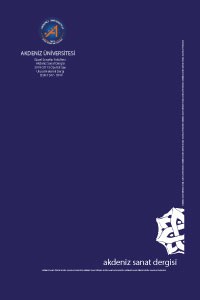Abstract
Cape Jason is located at the eastern end of the bay on which Fatsa and Bolaman were founded. The settlement was called "Iasonia Akte" in the ancient times. It is the largest cape on the Turkish coasts east of Sinop. There are three extensions to the sea in an area of 14 km. These
are Cape Çam in the East, Cape Çapraz in the middle, and Cape Jason in the west. The famous
geographer Strabon in his “Geographika” refers to Cape Jason as, “When you go along the coast after Samsun (Amisos), you will come to Cape Haraklia first and then to another place called Iasonion." Cape Jason was a territory of Hittites between 1700 and 1200 BC; of Phrygians between 1200 and 670 BC, and of Cimmerians between 670 and 546 BC.It became a land of Roman Empire in
64 AD and of Byzantium Empire in 395 AD. Between 1204 and 1461 AD it was a possession of Pontus
Empire. Cape Jason was added to the Turkish lands in 1461. It is located within the borders of the
Çaytepe Village of Perşembe District of Ordu Province.
Cape Jason’s land is wide and flat. The existing traces indicate that there are many
building remains on the cape. The standing buildings on the cape are a church built in 1868 and
restored in 2004, and a building remains, supposedly of a monastery, located in the south-east.
Depending on the historical sources, it is thought that, Cape Jason was used as a sanctuary from
the ancient period until its abandonment and ceremonies were organized according to the beliefs
of the period, and various buildings, including a pier, were built on it.
This study aims to discuss the geographical location, history and legend of Cape Jason
and introduces the church on it in detail, and other structures that can be determined.
Keywords
References
- AHANOV, A. (2004), Panaret’in Trabzon Tarihi, (Çev. Uzun, E)., Trabzon.
- BAŞ, M. (2014), İlkçağ’dan Günümüze Ordu Tarihi, Ankara.
- BIJIŞKYAN P. M. (1998), Pontos Tarihi, Tarihin Horona Durduğu Yer Karadeniz,(Çev. Andreasyan, H.), İstanbul.
- ERDOĞDU, İ. (2005). “Orta Karadeniz Bölgesinin Tarihi Coğrafyası”, Orta Karadeniz Kültürü, (Sempozyum Bildirileri), Ankara, ss. 21-33
- DİZMAN, İ. (2008), Denize Düşen Dağ: Ordu, İstanbul.
- DÖNMEZ, Ş. (2000), Türkiye Arkeolojisi ve İstanbul Üniversitesi, Ankara.
- EVLİYA ÇELEBİ, (2008), Seyahatname, 2.C.1. Kitap, İstanbul.
- FREELY, J. (2008), Türkiye Uygarlıklar Rehberi 2, (Çev. Birkan, T.-Koca, G.-Biçen, A.) İstanbul.
- HAMİLTON, W. J.(2013) Küçük Asya, (Çev. Toraman, A.) Ankara.
- KSENOPHON, (2010), Anabasis (Onbinlerin Dönüşü), (Çev. Gökçöl.T.), İstanbul.
- OKUYUCU, D., (2013). Orta ve Doğu Karadeniz Bölgesi Rum Kiliseleri, Atatürk Üniversitesi Sosyal Bilimler Enstitüsü (Yayımlanmamış Doktora Tezi) Erzurum.
- STRABON,(2015), Antik Anadolu Coğrafyası, (çev. Pekman.A.), İstanbul.
- UMAR, B. (2000), Karadeniz Kappadokia’sı (Pontos), İastanbul. YEDİYILDIZ, B. (2000), Ordu Tarihinden İzler, İstanbul.
Abstract
Yason Burnu, Fatsa ve Bolaman’ın kurulu olduğu körfezin doğu ucunda yer almaktadır.
Yerleşimin antik dönemdeki ismi “İasonia Akte”dir. Sinop’un doğusundaki Türk kıyılarının en
büyüğü Yason Burnu’dur. 14 km uzunluğundaki alanda denize doğru üç uzantı bulunmaktadır.
Bunlar; doğuda Çam Burnu, ortada Çapraz Burnu ve batıda Yason Burnu şeklinde sıralanmaktadır.
Ünlü coğrafyacı Strabon’un “Geographika”sında Samsun (Amisos)’dan sonra kıyı boyunca
gidildiğinde ilk önce Haraklia Burnuna, ondan sonra da Iasonion denen başka bir buruna
geliniyor dediği yerdir Yason. Tarihte; M.Ö. 1700-1200 yılları arasında Hitit, M.Ö. 1200—670 yılları
arasında Frig, M.Ö. 670-546 yılları arasında Kimmer, M.S. 64 yılında Roma, M.S. 395 yılından sonra
Bizans, M.S. 1204-1461yıllrında Pontus Rum İmparatorluğu, M.S. 1461 tarihinden sonra da Türk
topraklarına katılan Yason, Günümüzde Ordu ili Perşembe İlçesi, Çaytepe Köyü sınırları içerisinde
yer almaktadır.
Yason Burnu oldukça geniş ve düz bir araziye sahiptir. Günümüze ulaşan izler burun
üzerinde birçok yapı kalıntısının bulunduğunu işaret etmektedir. Burun üzerinde ayakta olan
yapılar, 1868 yılında yaptırılan ve 2004 yılında restore edilen kilise ile güney doğusunda yer
alan, manastıra ait olduğu düşünülen bir yapı kalıntısıdır. Tarihi kaynaklardan ve elde edilen
bulgulardan hareketle, Antik dönemden başlayıp terk edildiği döneme kadar “Yason Burnu”nun
kutsal alan olarak kullanıldığı ve buraya bir iskelenin yanında döneminin inançları gereğince
çeşitli binaların yapıldığı, törenler düzenlendiği düşünülmektedir.
Bu çalışmada Yason Burnu’nun coğrafi konumu, tarihçesi, efsanesi ele alınarak, üzerinde bulunan
kilise detaylı olarak tanıtılıp, tespit edilebilen diğer yapılar hakkında bilgi verilecektir.
Keywords
References
- AHANOV, A. (2004), Panaret’in Trabzon Tarihi, (Çev. Uzun, E)., Trabzon.
- BAŞ, M. (2014), İlkçağ’dan Günümüze Ordu Tarihi, Ankara.
- BIJIŞKYAN P. M. (1998), Pontos Tarihi, Tarihin Horona Durduğu Yer Karadeniz,(Çev. Andreasyan, H.), İstanbul.
- ERDOĞDU, İ. (2005). “Orta Karadeniz Bölgesinin Tarihi Coğrafyası”, Orta Karadeniz Kültürü, (Sempozyum Bildirileri), Ankara, ss. 21-33
- DİZMAN, İ. (2008), Denize Düşen Dağ: Ordu, İstanbul.
- DÖNMEZ, Ş. (2000), Türkiye Arkeolojisi ve İstanbul Üniversitesi, Ankara.
- EVLİYA ÇELEBİ, (2008), Seyahatname, 2.C.1. Kitap, İstanbul.
- FREELY, J. (2008), Türkiye Uygarlıklar Rehberi 2, (Çev. Birkan, T.-Koca, G.-Biçen, A.) İstanbul.
- HAMİLTON, W. J.(2013) Küçük Asya, (Çev. Toraman, A.) Ankara.
- KSENOPHON, (2010), Anabasis (Onbinlerin Dönüşü), (Çev. Gökçöl.T.), İstanbul.
- OKUYUCU, D., (2013). Orta ve Doğu Karadeniz Bölgesi Rum Kiliseleri, Atatürk Üniversitesi Sosyal Bilimler Enstitüsü (Yayımlanmamış Doktora Tezi) Erzurum.
- STRABON,(2015), Antik Anadolu Coğrafyası, (çev. Pekman.A.), İstanbul.
- UMAR, B. (2000), Karadeniz Kappadokia’sı (Pontos), İastanbul. YEDİYILDIZ, B. (2000), Ordu Tarihinden İzler, İstanbul.
Details
| Primary Language | Turkish |
|---|---|
| Journal Section | Articles |
| Authors | |
| Publication Date | October 1, 2019 |
| Submission Date | January 7, 2018 |
| Published in Issue | Year 2019 Volume: 13 - 21. Uluslararası Ortaçağ ve Türk Dönemi Kazıları ve Sanat Tarihi Araştımaları Sempozyumu Bildirileri |
Article submission for the July 2025 issue of Akdeniz Sanat 2025 (volume: 19 issue: 36) will take place between April 01-15, 2025.
The submit article button may give an error in Google Chrome browser. The problem is solved if you use a different browser.
Creative Commons License
Akdeniz Sanat is licensed under a Creative Commons Attribution-NonCommercial 4.0 International License.


